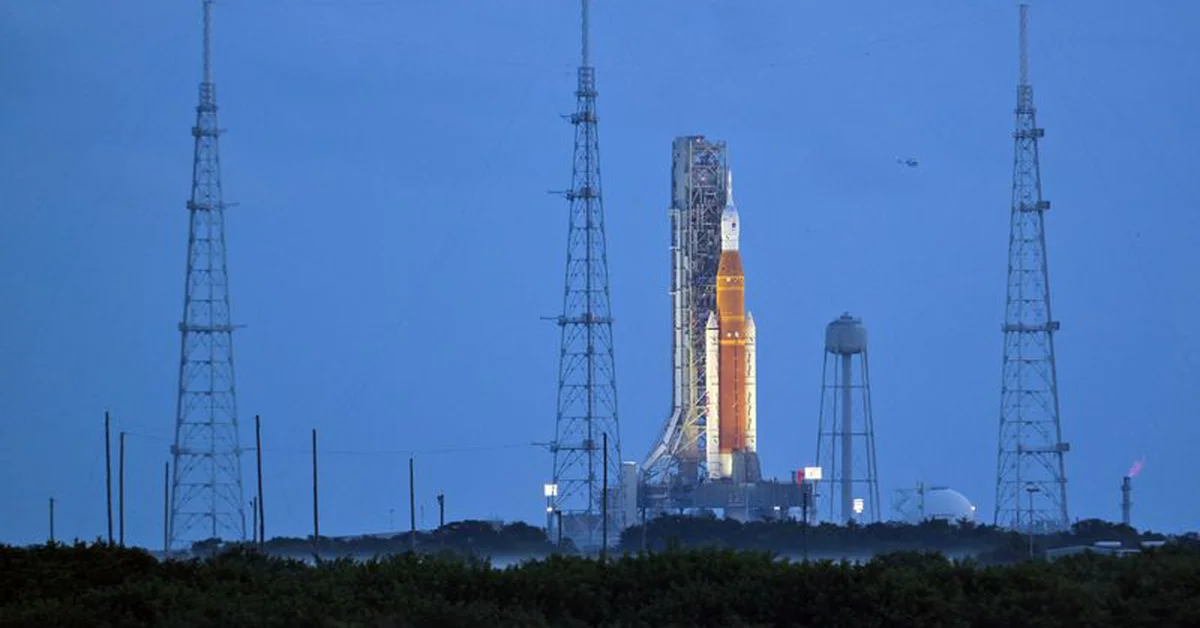They may pass several weeks Before NASA launched its largest moon rocket Space Launch System A second flight on Saturday was forced to be canceled after agency officials were unable to fix what they described as a large, uncontained hydrogen leak.
Agency officials said they believe so They may have to send the rocket back to its assembly building for repairs After two failed attempts, a first test flight would carry the untried Orion spacecraft to the moon.
The result is as follows Another day of disappointment for the space agencyIt was hoped to finally launch the rocket after years of delays and setbacks and would mark a major milestone in the return of astronauts to the lunar surface.
Instead, the next launch attempt will be well into October NASA struggles to understand the complex and unstable beast that is the rocket and its volatile propellant.
Although NASA officials say it’s a normal part of spaceflight, especially when a new rocket arrives, NASA’s failure to launch its flagship rocket is sure to renew criticism from some influenced by political preferences as a symbol of government mismanagement. and dependent on outdated technology.
:quality(85)/cloudfront-us-east-1.images.arcpublishing.com/infobae/4536CKMSHDMW235YYPGRTMYSLI.jpg 992w)
The rocket is billions of dollars over budget and years behind schedule, and by some estimates, each launch costs between 2,000 and 4,000 million dollars. In developing the rocket, Congress directed that engines and technology be recycled from the Space Shuttle program, which first flew in 1981 and was developed in the 1970s.
Unlike the rockets used by SpaceX to send astronauts to the International Space Station, the Space Launch System is non-reusable for returning to Earth.
Officials hoped that bringing the rocket to its first launch pad would be a statement that NASA had renewed its deep space ambitions. But instead of celebrating a successful flight to the moon, NASA officials spent most of Saturday morning trying to fix a leak of the volatile liquid hydrogen used as rocket fuel.
Hydrogen, the lightest element, is in liquid form at minus 217 degrees Celsius, and NASA had difficulty loading it into rocket tanks without leaking.
NASA encountered a similar problem during a launch test on Monday, but was eventually able to overcome it. However, on Saturday, engineers began loading hydrogen but stopped at 7:15 a.m. They then resumed but had to stop at 9 a.m. It started leaking again. They tried heating the line, then using helium to pressurize it, but nothing worked.
A second attempt to heat the line didn’t work either.
At 11:17 a.m., three hours before the launch, NASA ordered the shutdown. The leak was bigger than they discovered on Mondaysaid Mike Sarafin, director of the Artemis program. “Monday’s spill was a manageable spill,” he said. “This is not a manageable leak”. He said one of the hydrogen lines was inadvertently overpressured, but it was unclear what caused the leak or why the overpressure occurred.
:quality(85)/cloudfront-us-east-1.images.arcpublishing.com/infobae/GB72YR5JZDAMV6U3KKZX4WT7PU.jpg 420w,https://www.infobae.com/new-resizer/dH19d4_yJWLjdTrIPQVdd-vET2k=/768x1152/filters:format(webp):quality(85)/cloudfront-us-east-1.images.arcpublishing.com/infobae/GB72YR5JZDAMV6U3KKZX4WT7PU.jpg 768w,https://www.infobae.com/new-resizer/k47119TB2ODrFjJgY5uOggXlfK4=/992x1488/filters:format(webp):quality(85)/cloudfront-us-east-1.images.arcpublishing.com/infobae/GB72YR5JZDAMV6U3KKZX4WT7PU.jpg 992w,https://www.infobae.com/new-resizer/iHxQRpEM5ouRwdS8sjtxCRoj-J0=/1200x1800/filters:format(webp):quality(85)/cloudfront-us-east-1.images.arcpublishing.com/infobae/GB72YR5JZDAMV6U3KKZX4WT7PU.jpg 1200w)
Officials said they were considering whether to repair a leak in the launch pad and test it by flowing liquid hydrogen through it — something they wouldn’t be able to do if the rocket was brought back to the Assembly building. If the platform can’t be repaired, they have to take it back to the assembly building and repair it there, but they can’t confirm if the problem is fixed until another attempt.
In both cases, engineers had to reset the rocket’s emergency flight stop system, which would have destroyed it if it had been deflected during launch. This work can only be done in the assembly building.
For technical reasons or bad weather, Delays in the space program are nothing new. Officials said on Saturday that 121 of the 135 spacecraft launches were grounded at least once. In 20 cases, the shuttle returned to the Assembly building.
On Saturday, NASA Administrator Bill Nelson praised the SLS launch team, saying the agency would be cautious and not rush the launch until all systems are in place.
“We won’t go on a test flight until then and especially now,” Nelson said. NASA “will make sure it’s OK before putting four people on it.” Delays, he said, are “part of the space business.” He noted that scrubs are much less expensive than flaps.
As a member of Congress, Nelson flew on the space shuttle in 1986, but endured repeated delays. “We quit four times,” he said. “We are over a month late. . . It’s part of our space program: Be prepared for scrubs”.
As an astronaut preparing to fly on the space shuttle, Pam Melroy, now NASA’s deputy administrator, would tell her friends and family to plan a weeklong vacation to Florida’s Space Coast so they could “see an aval.”
The Artemis I mission, as it will be called, is a test to ensure that there are no astronauts on board and that the rocket and spacecraft are safe for human travel. If NASA can complete Artemis I, the next flight will fly four astronauts around the moon, possibly in 2024. A human landing on the moon’s surface could come in 2025 or 2026.
But as Saturday’s setback demonstrates, NASA still has many technical challenges to overcome. NASA is particularly cautious with its SLS rocket. It cost about $23 billion to build and the space agency hopes will serve as the backbone of its Artemis program, designed to return astronauts to the moon.
Artemis mission director Sarafin told reporters this week that about 500 launch criteria must be met, and any number could force the space agency to scrub it and try another day.
“There is no guarantee that we will take off,” he said. “But we’ll show up, we’ll try, we’ll do our best.”.
Saturday’s shutdown came after Monday, when engineers said they couldn’t get one of the four engines mounted on the booster platform to the proper temperature needed for launch. After stopping and investigating the problem, they determined it was a faulty sensor and tried again on Saturday.
Last year, NASA successfully loaded a rocket with 730,000 gallons of liquid hydrogen and liquid oxygen and tested the RS-25 engines during its eight-minute flight. But he could not repeat that success after that.
Earlier this year, during a series of fuel tests, it ran into all sorts of problems that prevented the space agency from running a full simulated countdown.
Despite those problems, NASA officials said they were confident enough to continue with the launch attempt. The attempts essentially served as additional fuel tests.
NASA astronaut Victor Glover, who will be among the crew selected for the Artemis lunar mission, said air traffic controllers should be commended for their decision to cancel the launch, especially since it received widespread public attention.
“It is difficult to make such a decision“, said. “We may be angry about the hydrogen leak, but the cancellation is absolutely the right decision, and it helps build confidence.”
© Washington Post 2022



:quality(85)/cloudfront-us-east-1.images.arcpublishing.com/infobae/SMPW7M5BQFERBOQUPJXKCOKARY.jpg)
:quality(85)/cloudfront-us-east-1.images.arcpublishing.com/infobae/NP5NEZXMZFGNLBHNEQJHPJVMKM.jpg)
